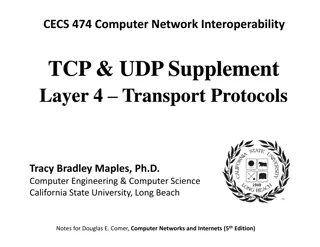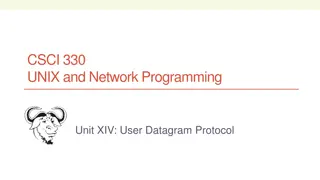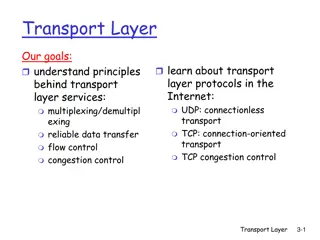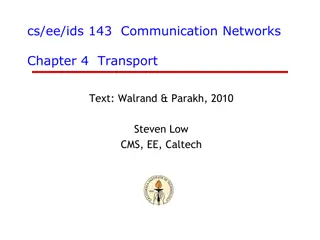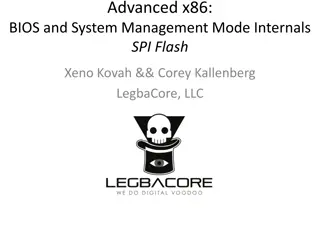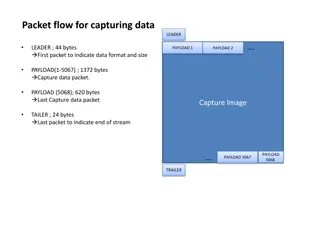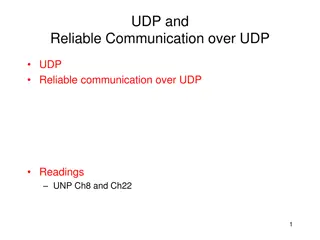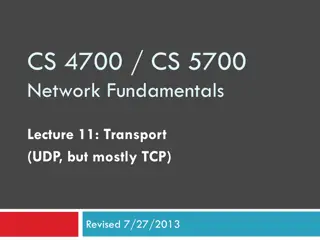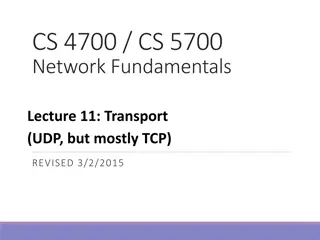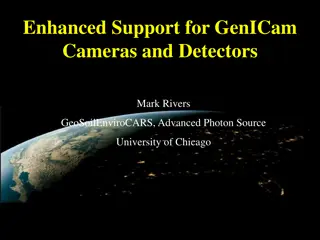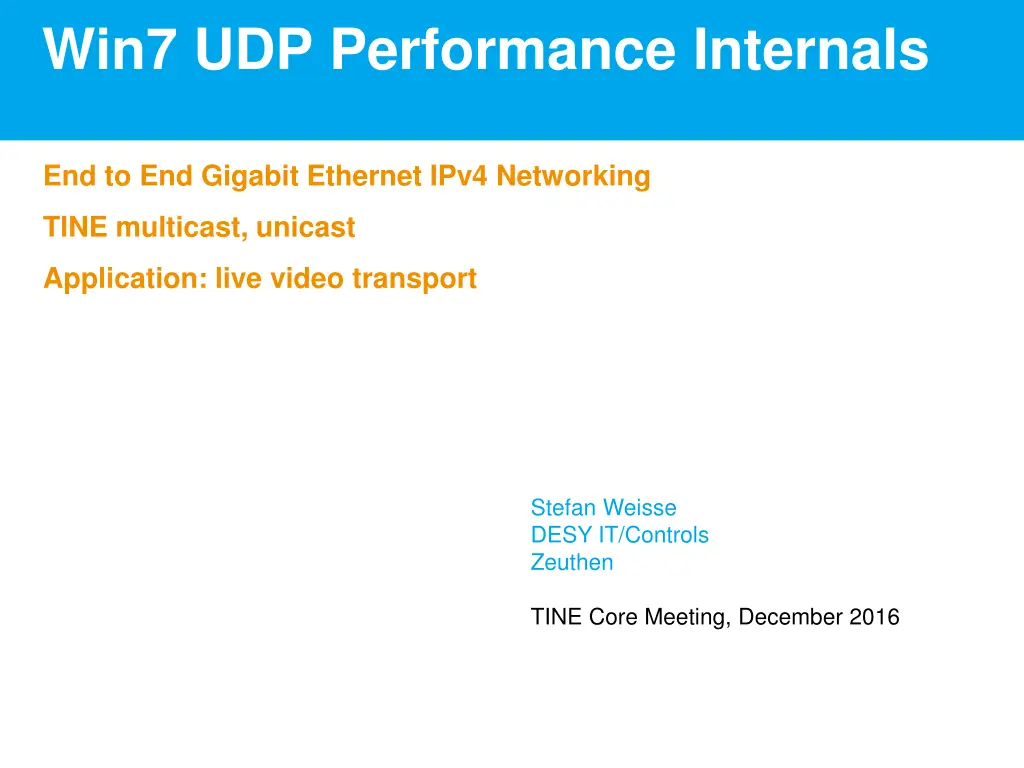
Win7 UDP Performance Internals for Gigabit Ethernet Networking
Explore the end-to-end performance analysis of Windows 7 UDP networking for Gigabit Ethernet, covering multicast and unicast applications. Detailed insights on achieving optimal performance, common pitfalls, and practical testbed scenarios are presented by Stefan Weisse in a December 2016 meeting at DESY IT/Controls Zeuthen. Host system specifications, network setup, and NIC tuning for improved transport reliability are discussed.
Download Presentation

Please find below an Image/Link to download the presentation.
The content on the website is provided AS IS for your information and personal use only. It may not be sold, licensed, or shared on other websites without obtaining consent from the author. If you encounter any issues during the download, it is possible that the publisher has removed the file from their server.
You are allowed to download the files provided on this website for personal or commercial use, subject to the condition that they are used lawfully. All files are the property of their respective owners.
The content on the website is provided AS IS for your information and personal use only. It may not be sold, licensed, or shared on other websites without obtaining consent from the author.
E N D
Presentation Transcript
Win7 UDP Performance Internals End to End Gigabit Ethernet IPv4 Networking TINE multicast, unicast Application: live video transport Stefan Weisse DESY IT/Controls Zeuthen TINE Core Meeting, December 2016
Win7 UDP Performance Internals Overview > What is possible? (MB/s) > How one can achieve that? > What has shown to fail in practice? (how one can not achieve that) > Reproduce cases on Testbed with two hosts: host znpfg5: sender with a dedicated GigE camera host znpfg3: receiver both hosts monitored via Microsoft Remote Desktop Connection (RDP)! Stefan Weisse | Win7 UDP Performance | December 2016 | Seite 2/30
Win7 UDP Performance Internals Network Setup Stefan Weisse | Win7 UDP Performance | December 2016 | Seite 3/30
Win7 UDP Performance Internals Host Details > Sender s system specs: Hostname: znpfg5 CPU: Intel Core 2 Duo E8400: 3.0 GHz, 2 cores Motherboard: Intel DX38BT 8 GB RAM (Non-ECC) Windows 7 64-bit Enterprise (DESY: Firewall and Virus Scanner enabled) Intel 82566DC-2 Gigabit Network Connection (on-board): DESY LAN Intel Gigabit CT Desktop Adapter (PCIe x1) : Camera Input (via 1:1 Cable to Camera) Stefan Weisse | Win7 UDP Performance | December 2016 | Seite 4/30
Win7 UDP Performance Internals Host Details > Receiver s system specs: Hostname: znpfg3 CPU: Intel Core 2 Duo E8400: 3.0 GHz, 2 cores Motherboard: Intel DX38BT 4 GB RAM (Non-ECC) Windows 7 64-bit Enterprise (DESY: Firewall and Virus Scanner enabled) Intel 82566DC-2 Gigabit Network Connection (on-board): DESY LAN Common off-the-shelf (COTS) Rackmount PC Stefan Weisse | Win7 UDP Performance | December 2016 | Seite 5/30
Win7 UDP Performance Internals Host Details > Intel Network Interface Card (NIC) Tuning Receive Buffers: 256 -> 2048 (max) When dealing with the high throughput UDP traffic a GigE camera can provide, enlarging receive buffers has shown to improve transport reliability (few dropped packets or dropped frames -> no dropped packets/dropped frames) According to a test which I ve done it s not clear whether increasing number of receive buffers has a positive effect on transfer stability as shown in this presentation No negative side effects have been observed Stefan Weisse | Win7 UDP Performance | December 2016 | Seite 6/30
Win7 UDP Performance Internals Image Source Details > Prosilica GC1350M 1360x1024 pixel Monochrome 12 bits per pixel (as 2 bytes per pixel) Up to 20 Hz full frame read out (20.065 Hz) Total possible (net) bandwidth: 53.13 MB/s (55.705.600 bytes per second) (1360 x 1024 x 2 x 20) As comparison: Highest in practice observed Gigabit Ethernet bandwidth (with TCP): 109 MB/s (NetIO benchmark v1.31) Stefan Weisse | Win7 UDP Performance | December 2016 | Seite 7/30
Win7 UDP Performance Internals Goal >A transfer is very stable if: Less than 1 per 1000 frames is dropped, for more than 10 minutes Stefan Weisse | Win7 UDP Performance | December 2016 | Seite 8/30
Win7 UDP Performance Internals Settings which are not modified across tests runs > Camera Prosilica GC1350M (connected to znpfg5) delivering 1360x1024x12 bit -> 2.785.280 bytes / image > TINE server (on znpfg5) Lazy scheduling CycleDelay=0 SGP_ProsilicaGigE.exe: C/C++ 32-bit Windows executable, using tine32.dll* > TINE client (on znpfg3) Multicast, 2000ms polling interval socket receive buffer: 4.194.304 bytes TineFrameTransferTestV3.exe: C/C++ 32-bit Windows executable, using tine32.dll* *: tine32.dll v4.5.10 build 5248 (Jun 16, 2016) Stefan Weisse | Win7 UDP Performance | December 2016 | Seite 9/30
Win7 UDP Performance Internals Bandwidth Demands > 1 video frame 1360x1024 pixel, 2 bytes per pixel -> 2.785.280 bytes (2.66 MB) > UDP packet size: 1024 bytes packets/s: 2720 @ 1 Hz, 27200 @ 10 Hz, 54400 @ 20 Hz > UDP packet size: 1472 bytes Rough Estimate! packets/s: 1893 @ 1 Hz, 18930 @ 10 Hz, 37860 @ 20 Hz > UDP packet size: 9000 bytes packets/s: 310 @ 1 Hz, 3100 @ 10 Hz, 6200 @ 20 Hz > UDP packet size: 16384 bytes packets/s: 170 @ 1 Hz, 1700 @ 10 Hz, 3400 @ 20 Hz > Not taking into account TINE UDP packet header size! Stefan Weisse | Win7 UDP Performance | December 2016 | Seite 10/30
Win7 UDP Performance Internals Bandwidth Demands > High number of UDP packets require high effort for each TINE packet, a TINE header is appended, lowering the possible bandwidth (but not much) a lot of code in TINE is run for each packet, same is true on a lower level for operating system, driver of NIC CPU is heavily utilized for a huge number of packets per second Stefan Weisse | Win7 UDP Performance | December 2016 | Seite 11/30
Win7 UDP Performance Internals IP fragmentation and reassembly? > Common operating systems (at least non-embedded Linux, Windows) support IP fragmentation and reassembly > Idea: set TINE PacketMTU to a huge number, e.g. 16384, effectively lowering the number of TINE packets that need to be produced, send, received and decoded > TCP/IP firmware across the path will split the big UDP packet into fragments small enough to be transported on the underlying layer, client will reassemble the fragments (if all fragments arrive the client) > Drawback: Not all operating systems support IP fragmentation and reassembly > In principle a promising idea, but in practice Stefan Weisse | Win7 UDP Performance | December 2016 | Seite 12/30
Win7 UDP Performance Internals IP fragmentation and reassembly?? > Transfer specs 2.66 MB/frame, 20 Hz PacketMTU=16384 bytes, BurstLimit=3, SocketSendBufferKB=64 CycleDelay=0, MicroDelay=100 > First observation after starting the transfer: CPU load is pretty low, transfer is stable at a frame rate which was not expected to be reached (20 Hz -> 53.1 MB/s) > But after some time (usually minutes) . Transfer starts to drop more and more frames per second > And some time later on client, incoming traffic is still present, but no data reaches the client application eventually, some time later, network load drops to almost zero (multicast traffic stops) Stefan Weisse | Win7 UDP Performance | December 2016 | Seite 13/30
Win7 UDP Performance Internals IP reassembly buffer pool exhaust: Unfreeze Multicast > Stop transfer > Observe Windows Task Manager, that network load is getting low > Wait two minutes > Transfer should be able to be restarted, and should run with little or no data losses If not then wait five minutes > The above recipe does not always bring back a very stable transfer, even though an improvement is always there network weather conditions? Stefan Weisse | Win7 UDP Performance | December 2016 | Seite 14/30
Win7 UDP Performance Internals Screencast: transfer break, unfreeze hanging transfer > Video: ip-reassembly-buffer-pool-exhaust-mcast-DenOfSrv-Jul12- 2016.mp4 (3m15s, 7.1 MB) no video frame reaches the client application in Windows task manager (networking tab), one can see a large network utilization on server as well as client side netstat*, on client, shows expected high number of fragments incoming (~41000/s) netstat*, on client, does not show expected number of successful reassemblies (less than 50/s are shown, but more than 3400/s expected) at 0m51s, the transfer is stopped by hand one can see in Windows task manager (networking tab) that network load drops almost immediately to zero at 1m50s, the transfer is restarted at 2m28s, first frame is dropped up to the end: frame drops increase, but do not reach fatal level (yet ) *: netstat -s -p IP -t 1 Stefan Weisse | Win7 UDP Performance | December 2016 | Seite 15/30
Win7 UDP Performance Internals IP reassembly failure > IP reassembly is not stable enough at high data rates > IP reassembly buffer exhaust? Due to UDP fragments not reaching the client, other fragments of the same macropacket block buffer space in the IP reassembly pool, if IP reassembly is successful, buffer space is released quickly, available for new packets as they come in, but if some fragment is missing, other fragments of the same macropacket block space in the IP reassembly pool for seconds to minutes ([technet], [rfc2460], [rfc791]) > Reassembly fragment number only 16 bit? reassembled macroblock checksum mismatch? [rfc4963] [technet] http://blogs.technet.com/b/nettracer/archive/2010/08/10/3335600.aspx [rfc2460] http://www.ietf.org/rfc/rfc2460.txt [rfc791] http://www.ietf.org/rfc/rfc791.txt [rfc4963] http://www.ietf.org/rfc/rfc4963.txt Stefan Weisse | Win7 UDP Performance | December 2016 | Seite 16/30
Win7 UDP Performance Internals IP reassembly buffer pool exhaust > As far as I know Limited possibilities to trace IP reassembly buffers (statistics) No possibilities to tweak the pool (e.g. adjust timeout, enlarge buffer space) > If the bandwidth demand is low, no issue has been observed Multicast 3.66 MB/s (1600x1200x2 byte per pixel at 1 Hz) in Hamburg @ PETRA > But if bandwidth demand is high, sooner or later degrading of transfer stability has been observed, even though it s not clearly reproducable dependency on overall network load? also dependency on client network load suspected at 5 Hz (13.28 MB/s): no issue observed (running for more than two days) at 7 Hz (18.59 MB/s): issue reproduced (took more than 20 hours until fatal) Stefan Weisse | Win7 UDP Performance | December 2016 | Seite 17/30
Win7 UDP Performance Internals Maximum fragment-free UDP Packet Size? > If going high bandwidth, IP fragmentation and reassembly looks like no way to go right now > as a consequence, TINE needs to operate on small packet size, which puts high demand on CPU modern desktop CPUs (Haswell, Skylake, especially 4+-core) are supposed to handle this, but 5 year old Core 2 Duo may not > What s the maximum UDP packet size which is not fragmented? (no fragmentation and reassembly while retaining lowest possible number of packets per second) in general, on LAN, 1472 bytes is a good guess Stefan Weisse | Win7 UDP Performance | December 2016 | Seite 18/30
Win7 UDP Performance Internals Maximum fragment-free UDP Packet Size C:\Windows\System32>ping /? Usage: ping [-t] [-a] [-n count] [-l size] [-f] [-i TTL] [-v TOS] [-r count] [-s count] [[-j host-list] | [-k host-list]] [-w timeout] [-R] [-S srcaddr] [-4] [-6] target_name Options: -t Ping the specified host until stopped. To see statistics and continue - type Control-Break; To stop - type Control-C. -a Resolve addresses to hostnames. -n count Number of echo requests to send. -l size Send buffer size. -f Set Don't Fragment flag in packet (IPv4-only). -i TTL Time To Live. -v TOS Type Of Service (IPv4-only. This setting has been deprecated and has no effect on the type of service field in the IP Header). -r count Record route for count hops (IPv4-only). -s count Timestamp for count hops (IPv4-only). -j host-list Loose source route along host-list (IPv4-only). -k host-list Strict source route along host-list (IPv4-only). -w timeout Timeout in milliseconds to wait for each reply. -R Use routing header to test reverse route also (IPv6-only). -S srcaddr Source address to use. -4 Force using IPv4. -6 Force using IPv6. Stefan Weisse | Win7 UDP Performance | December 2016 | Seite 19/30
Win7 UDP Performance Internals Maximum fragment-free UDP Packet Size [znpfg3] C:\temp\sweisse\netio>ping -l 1473 -f znpfg5 [znpfg3] C:\temp\sweisse\netio>ping -l 1472 -f znpfg5 Pinging znpfg5.ifh.de [141.34.30.215] with 1473 bytes of data: Packet needs to be fragmented but DF set. Packet needs to be fragmented but DF set. Packet needs to be fragmented but DF set. Ping statistics for 141.34.30.215: Packets: Sent = 2, Received = 2, Lost = 0 (0% loss), Approximate round trip times in milli-seconds: Minimum = 0ms, Maximum = 0ms, Average = 0ms Control-C ^C Pinging znpfg5.ifh.de [141.34.30.215] with 1472 bytes of data: Reply from 141.34.30.215: bytes=1472 time<1ms TTL=128 Reply from 141.34.30.215: bytes=1472 time<1ms TTL=128 Ping statistics for 141.34.30.215: Packets: Sent = 3, Received = 0, Lost = 3 (100% loss), Control-C ^C [znpfg3] C:\temp\sweisse\netio>ping -l 1472 -f znpfg5 Pinging znpfg5.ifh.de [141.34.30.215] with 1472 bytes of data: Reply from 141.34.30.215: bytes=1472 time<1ms TTL=128 Reply from 141.34.30.215: bytes=1472 time<1ms TTL=128 Reply from 141.34.30.215: bytes=1472 time<1ms TTL=128 Ping statistics for 141.34.30.215: Packets: Sent = 3, Received = 3, Lost = 0 (0% loss), Approximate round trip times in milli-seconds: Minimum = 0ms, Maximum = 0ms, Average = 0ms Control-C ^C Stefan Weisse | Win7 UDP Performance | December 2016 | Seite 20/30
Win7 UDP Performance Internals First non-fragmented transport: low max. bandwidth > Using maximum packet size without fragmentation (1472 bytes) > Maximum achievable bandwidth is unexpected slow (17 MB/s) why? Stefan Weisse | Win7 UDP Performance | December 2016 | Seite 21/30
Win7 UDP Performance Internals Out of the box: Poor UDP performance FG3 to FG5 NetIO UDP Throughput (Win7 Standard Settings) 140.00 119.21 119.21 120.00 105.32 103.40 102.31 100.00 80.23 80.00 72.61 TX (MB/s) 56.10 60.00 RX (MB/s) 40.00 18.41 18.12 20.00 12.72 12.55 0.00 1024 1025 1472 TCP 1k Obs. UDP Max. GigE Max Packet Size (Bytes) | Observed Maximum | Gigabit Maximum Stefan Weisse | Win7 UDP Performance | December 2016 | Seite 22/30
Win7 UDP Performance Internals Registry Settings HKLM\SYSTEM\CurrentControlSet\services\AFD\Parameters > FastCopyReceiveThreshold REG_DWORD Default: 1024 (0x400) Recommended: 1500 (0x5dc) little impact on receive assumed > FastSendDatagramThreshold REG_DWORD Default: 1024 (0x400) Recommended: 1500 (0x5dc) huge impact on send Stefan Weisse | Win7 UDP Performance | December 2016 | Seite 23/30
Win7 UDP Performance Internals Registry Settings HKLM\SOFTWARE\Microsoft\Windows NT\CurrentVersion\Multimedia\SystemProfile > NetworkThrottlingIndex REG_DWORD Default value: 0xa Recommended: 0xffffffff (4294967295) Impact unknown In general: No negative side-effects observed. Stefan Weisse | Win7 UDP Performance | December 2016 | Seite 24/30
Win7 UDP Performance Internals Optimized UDP performance FG3 to FG5 NetIO UDP Throughput (Win7 Performance Settings) 140.00 119.21 119.21 120.00 105.46 104.45 103.40 102.52 100.00 80.23 80.06 80.00 73.19 71.92 TX (MB/s) 56.48 60.00 RX (MB/s) 55.62 40.00 20.00 0.00 1024 1025 1472 TCP 1k Obs. UDP Max. GigE Max Packet Size (Bytes) Stefan Weisse | Win7 UDP Performance | December 2016 | Seite 25/30 | Observed Maximum | Gigabit Maximum
Win7 UDP Performance Internals Win 7 Standard Settings: What s possible > Camera Framerate 11.0 Hz (29.22 MB/s) > TINE Server: PacketMTU=1024, BurstLimit=30, MicroDelay=10, default SocketSendBufferSize=32 KB > Result: less than 1 per 1000 frames dropped (runtime 15m19s: 10102 frames rcvd, 6 dropped ) > In comparison: 12.2 Hz (32.41 MB/s) results in 3 per 1000 frames dropped (13m47s: 10059 frames rcvd, 31 dropped) > Main bottleneck assumed: CPU load (on server and on client around 50% on dual-core machine) Stefan Weisse | Win7 UDP Performance | December 2016 | Seite 26/30
Win7 UDP Performance Internals Win 7 Performance Settings: What s possible > Camera Framerate 15.5 Hz (41.2 MB/s) > TINE Server: PacketMTU=1472, BurstLimit=21, MicroDelay=10, default SocketSendBufferSize=32 KB > Result: less than 1 per 1000 frames dropped (runtime 10m54s: 10119 frames rcvd, 9 dropped ) > In comparison: 16.0 Hz (42.5 MB/s) results in 1.8 per 1000 frames dropped (10m49s: 10350 frames rcvd, 19 dropped) 16.5 Hz (43.8 MB/s) results in 4 per 1000 frames dropped (10m21s: 10213 rcvd, 40 dropped) > Main bottleneck assumed: CPU load (on server and on client around 50% on dual-core machine) Stefan Weisse | Win7 UDP Performance | December 2016 | Seite 27/30
Win7 UDP Performance Internals Win7 Performance vs. Standard (video transmission) > Camera Framerate Standard: 11.0 Hz (29.22 MB/s) Performance: 15.5 Hz (41.2 MB/s) > +11.95 MB/s > Both Standard and Performance suffer from busy CPU (higher network bandwidth occupation on less busy CPU expected) Stefan Weisse | Win7 UDP Performance | December 2016 | Seite 28/30
Win7 UDP Performance Internals Summary > Out of the box, UDP bandwidth of packet size >1024 bytes surprisingly low > IP reassembly showed denial of service in real world environment > In wide field: stick to Win7 standard settings, re-adjust TINE to PacketMTU=1024, keep transfer rate low (20 MB/s, maybe 25 MB/s) > In lab: consider windows 7 performance settings, use TINE default PacketMTU=1472, a transfer rate of 40 MB/s is possible > MicroDelay can be used as a handbrake to saturate possible TINE bandwidth before network level issues occur > TINE Send buffer should be kept at default size (32 KB) > on receive side, enlarging of socket buffer is highly recommended (rule of thumb: 1 video frame should fit in receive socket buffer) Stefan Weisse | Win7 UDP Performance | December 2016 | Seite 29/30
Win7 UDP Performance Internals Thank you for your attention! Question? Comments? Remarks? Stefan Weisse | Win7 UDP Performance | December 2016 | Seite 30/30


